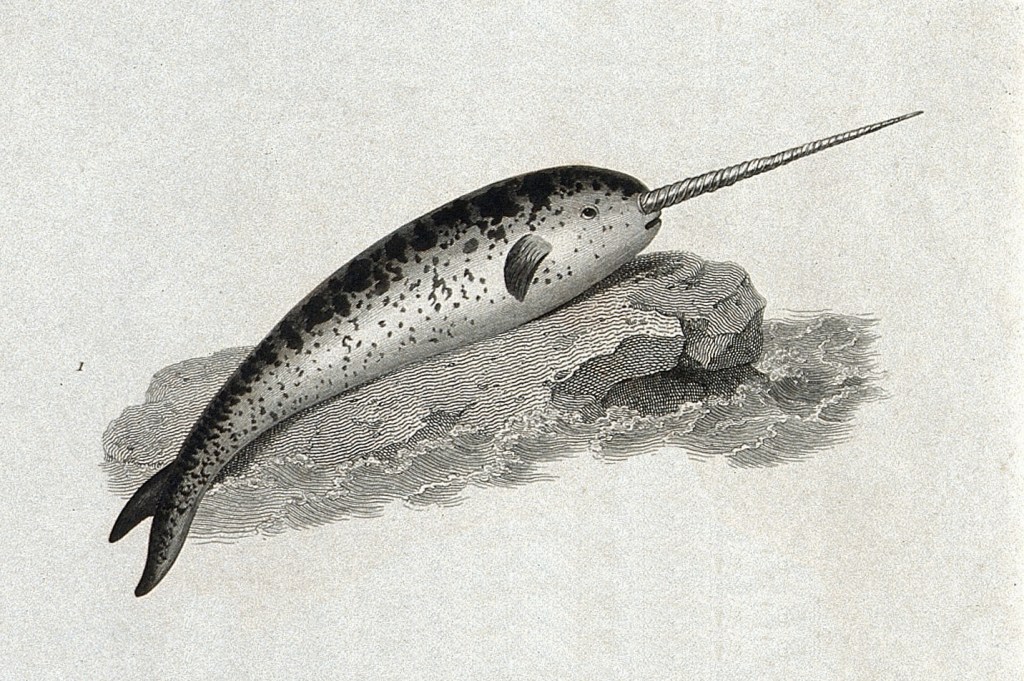You may be thinking, at this particular moment, about narwhals. It’s unlikely, but it’s more probable than it would have been a week ago, given the improbable insertion of the toothed whale species known as Monodon monoceros into the current news cycle. In a horrific incident that left two dead, a knife-wielding terrorist on London Bridge was stopped from further destruction in part by a man brandishing a five-foot-long narwhal tusk. (They’re not cheap weapons, on that note.)This opened up a litany of confessions on Twitter in which plenty of otherwise sane adults admitted they didn’t think the narwhal actually existed. Here are a few of the things that surface when you search Twitter for ‘narwhals real’:‘Ok, I have to admit that I didn’t know narwhals were actually real until that thing in London yesterday. I thought they were just some kind of mythological sea-unicorn.’‘Today feels like a good day to share that I didn’t know narwhals were real until two years ago. I thought Elf made them up until they popped up on an episode of Planet Earth.’‘wow I didn’t even know Narwhals were real and I am shook’But the narwhal is, in fact, a living and breathing creature, even if it seems more at home among mythological brethren like the Loch Ness Monster and the Chupacabra.  Lurking in the frigid Arctic waters around Russia, Canada and Greenland, and capable of diving to nearly 5,000 feet below sea level, the narwhal can grow to as long as 18 feet, and is most famous for having a canine tooth that (primarily in males) bursts through the upper lip and grows into a 5- to 10-foot-long tusk. Their habitat is sufficiently inaccessible that most people will never see one, even for touristic reasons. Their tusks were, according to research, occasionally used to perpetuate allegations that the mythical unicorn was real. Even their name suggests a connection to the macabre and unknowable: it’s derived from the Old Norse word nár, which means ‘corpse’, in a reference to the fact that the creatures often lie still near the surface of the ocean, their mottled gray skin giving the appearance of drowned bodies.Narwhals are unquestionably odd creatures. Indeed, reading about them gives me immense empathy for the unfortunate human who first saw one of these things in the flesh and subsequently had to try to convince his or her compatriots that it was real.But perhaps there’s another reason why, until recent events, so many otherwise knowledgeable adults had been under the impression that narwhals were mythical creatures: The internet has effectively (and perhaps inadvertently) taken them out of the realm of aquatic mammals and turned them into something that seems more at home in the Pokémon taxonomy. Do a search on Etsy or Pinterest for ‘narwhal’, and your results will be dominated not by photography or otherwise inspiring nature imagery, but rather by ideas for kids’ narwhal-themed birthday parties, tutorials for narwhal-shaped cookies, and inspirational images with tusked cartoon whales that are accompanied by captions like ‘STAY NARLY’ or ‘ALWAYS BE YOURSELF. UNLESS YOU CAN BE A NARWHAL. THEN ALWAYS BE A NARWHAL.’ It’s much of the same it’s-cool-to-be-weird motivational speak that we associate with cartoon unicorns. Go back a bit further into internet history and you’ll find a mostly-forgotten viral song that exclaimed ‘Narwhals! Narwhals! Swimming in the ocean / Causing a commotion / Because they are so awesome!’ Again, they may as well have been characters from SpongeBob Squarepants.It’s remarkable in a sense. The internet has been quite adept at blurring the line between truth and fiction, but usually we talk about its effects in the context of believing things that aren’t true. In the case of the narwhal, its cuddly and Pinterest-y internet fame appears to have sufficiently mythologized it so that some people have forgotten — or never knew in the first place — about its flesh-and-blood counterpart.Somewhat ironically, the elusive narwhal’s closest living relative is one of the best-known and most accessible of cetaceans: the beluga whale, immortalized in singer Raffi’s 1980 kiddie music classic ‘Baby Beluga’. There are a handful of aquariums that house them, but if you (admirably) don’t believe whales should be kept in captivity, it’s nevertheless pretty easy to see belugas in the wild. A few months ago I saw a trio of them playfully poking their comically smooth white heads above the water while on a two-hour whale-watching tour of the Saguenay Fjord, an easy drive up the St Lawrence River from Québec City. Yet even the beluga has its mysterious side: earlier this year an evidently tame specimen wearing a harness showed up in Norway, causing speculation that it may have been trained as a spy whale by the Russian military. No one’s been able to prove it, though — to quote a local, ‘I’m not sure anyone would admit having lost a whale.’Whales are inherently unnerving creatures. On the one hand (or pectoral fin?) the sheer mass of many of them, and their seeming capability of casually swallowing a human like it was a bacon-wrapped scallop off a tray of hors d’oeuvres, has inspired everything from the biblical story of Jonah to Moby-Dick to at least one song by the Decemberists. On the other hand, they’re well-documented as some of the most intelligent animals on the planet, with complex social structures and systems of communication; they also, in some cases, mourn their dead. Spending their lives underwater, out of contact with terrestrial civilization and going about their business at a pace that seems like it exists on another dimension — recently, the heartbeat of the enormous blue whale was recorded for the first time, and it’s as slow as two beats per minute — whales are the closest thing to space aliens that we have on earth.So perhaps it’s unsurprising that narwhals, arguably the weirdest of all those weird mammals we know as whales, teeter on the edge of believability. On the internet, where the real and the fake slosh together like fresh and saltwater colliding in an estuary, the narwhal had apparently drifted out on the tides into the realm of the mythological.
Lurking in the frigid Arctic waters around Russia, Canada and Greenland, and capable of diving to nearly 5,000 feet below sea level, the narwhal can grow to as long as 18 feet, and is most famous for having a canine tooth that (primarily in males) bursts through the upper lip and grows into a 5- to 10-foot-long tusk. Their habitat is sufficiently inaccessible that most people will never see one, even for touristic reasons. Their tusks were, according to research, occasionally used to perpetuate allegations that the mythical unicorn was real. Even their name suggests a connection to the macabre and unknowable: it’s derived from the Old Norse word nár, which means ‘corpse’, in a reference to the fact that the creatures often lie still near the surface of the ocean, their mottled gray skin giving the appearance of drowned bodies.Narwhals are unquestionably odd creatures. Indeed, reading about them gives me immense empathy for the unfortunate human who first saw one of these things in the flesh and subsequently had to try to convince his or her compatriots that it was real.But perhaps there’s another reason why, until recent events, so many otherwise knowledgeable adults had been under the impression that narwhals were mythical creatures: The internet has effectively (and perhaps inadvertently) taken them out of the realm of aquatic mammals and turned them into something that seems more at home in the Pokémon taxonomy. Do a search on Etsy or Pinterest for ‘narwhal’, and your results will be dominated not by photography or otherwise inspiring nature imagery, but rather by ideas for kids’ narwhal-themed birthday parties, tutorials for narwhal-shaped cookies, and inspirational images with tusked cartoon whales that are accompanied by captions like ‘STAY NARLY’ or ‘ALWAYS BE YOURSELF. UNLESS YOU CAN BE A NARWHAL. THEN ALWAYS BE A NARWHAL.’ It’s much of the same it’s-cool-to-be-weird motivational speak that we associate with cartoon unicorns. Go back a bit further into internet history and you’ll find a mostly-forgotten viral song that exclaimed ‘Narwhals! Narwhals! Swimming in the ocean / Causing a commotion / Because they are so awesome!’ Again, they may as well have been characters from SpongeBob Squarepants.It’s remarkable in a sense. The internet has been quite adept at blurring the line between truth and fiction, but usually we talk about its effects in the context of believing things that aren’t true. In the case of the narwhal, its cuddly and Pinterest-y internet fame appears to have sufficiently mythologized it so that some people have forgotten — or never knew in the first place — about its flesh-and-blood counterpart.Somewhat ironically, the elusive narwhal’s closest living relative is one of the best-known and most accessible of cetaceans: the beluga whale, immortalized in singer Raffi’s 1980 kiddie music classic ‘Baby Beluga’. There are a handful of aquariums that house them, but if you (admirably) don’t believe whales should be kept in captivity, it’s nevertheless pretty easy to see belugas in the wild. A few months ago I saw a trio of them playfully poking their comically smooth white heads above the water while on a two-hour whale-watching tour of the Saguenay Fjord, an easy drive up the St Lawrence River from Québec City. Yet even the beluga has its mysterious side: earlier this year an evidently tame specimen wearing a harness showed up in Norway, causing speculation that it may have been trained as a spy whale by the Russian military. No one’s been able to prove it, though — to quote a local, ‘I’m not sure anyone would admit having lost a whale.’Whales are inherently unnerving creatures. On the one hand (or pectoral fin?) the sheer mass of many of them, and their seeming capability of casually swallowing a human like it was a bacon-wrapped scallop off a tray of hors d’oeuvres, has inspired everything from the biblical story of Jonah to Moby-Dick to at least one song by the Decemberists. On the other hand, they’re well-documented as some of the most intelligent animals on the planet, with complex social structures and systems of communication; they also, in some cases, mourn their dead. Spending their lives underwater, out of contact with terrestrial civilization and going about their business at a pace that seems like it exists on another dimension — recently, the heartbeat of the enormous blue whale was recorded for the first time, and it’s as slow as two beats per minute — whales are the closest thing to space aliens that we have on earth.So perhaps it’s unsurprising that narwhals, arguably the weirdest of all those weird mammals we know as whales, teeter on the edge of believability. On the internet, where the real and the fake slosh together like fresh and saltwater colliding in an estuary, the narwhal had apparently drifted out on the tides into the realm of the mythological.
You may be thinking, at this particular moment, about narwhals. It’s unlikely, but it’s more probable than it would have been a week ago, given the improbable insertion of the toothed whale species known as Monodon monoceros into the current news cycle. In a horrific incident that left two dead, a knife-wielding terrorist on London Bridge was stopped from further destruction in part by a man brandishing a five-foot-long narwhal tusk. (They’re not cheap weapons, on that note.)This opened up a litany of confessions on Twitter in which plenty of otherwise sane adults admitted they…


















